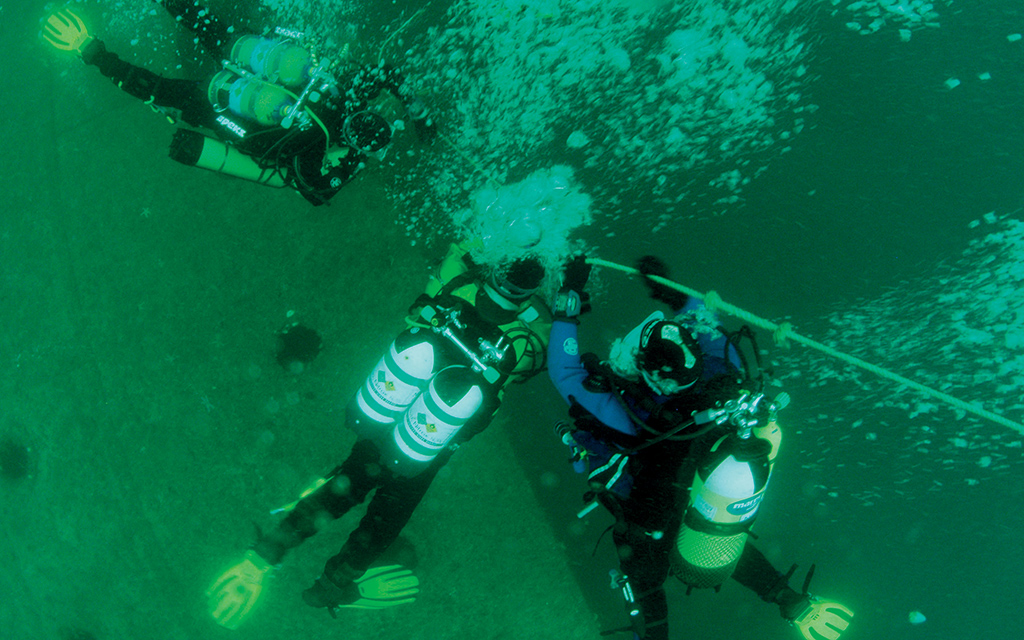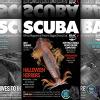
Despite Jacques Cousteau’s descriptions of a ‘silent world’, Becky Hitchin turns to the wider issue of noise in the sea.
Last month I left all the rebreather divers feeling smug at not producing the normal Darth Vader-esque inhalations and exhalations of open circuit divers. And yes, Darth Vader’s breathing noises were recorded from regulators. Dacor ones, as it happens. Now I’m going to disabuse that smugness. Well, at least slightly. This month I want to discuss the noises that we scuba divers put out into the water column, and also consider one of the man-made noises that we used to get to hear.
So how do we make noise underwater? Mainly from the creation of bubbles. These can be from obvious sources, such as the bubbles created on exhalation through a regulator, but also a huge number of less obvious sources, such as from fin movements and even inhalation. Also, that well-known high-pitched squeaking at your buddy when you see a lumpsucker or other such desired critter, or when you realise your drysuit zip isn’t quite done up properly.
sounds from divers... are detectable by fish more than 200m away from the diver
There have been several scientific studies looking at the types and magnitudes of noise emissions from various sets of diving equipment – open circuit, semi-closed and closed circuit, using a variety of makes and models of both open and closed circuit. Results from trials in New Zealand were particularly interesting. Scientists found that they could easily hear divers in the sea over the ambient levels of noise using not only open, but also semi-closed and closed systems, though of course open circuit systems were found to be loudest and more rhythmical.
They also found that noise levels tended to be louder at greater depths. Experiments showed that sounds from divers wearing both open circuit or semi-closed systems were detectable by fish more than 200m away from the diver. Detection did drop dramatically for the closed system, but fish could still detect the noise at 12.5m.
So that’s the minimum noise you produce. Anything above that is up to you. Tank bangers, horns, DPVs, singing songs to yourself will all increase your noise load. Of course, your total noise load over a dive will also depend on whether you slip into the sea like a selkie returning to their natural state, or if you’re more like me, splashing, almost falling over and laughing a lot - either from the shore or a boat.
Should we also count the boat thrusters and propellers? The lift entering the water to pick each diver up? The swearing as you wade back to shore through entangling strands of seaweed seemingly trying to drag you back down into the sea?
So, what can a diver hear? It depends on location. Coral reefs are jam packed with noise, from bubbles making their way through three dimensional mazes of coral to parrotfish very loudly crumbling the aforementioned coral to grind it to sand. There are mantis shrimps breaking the sound barrier exploding from their burrows to ensnare prey. It’s known widely now that ecosystems have their own soundscapes and a healthy coral reef has been said to sound like popping corn.
In more temperate climes, parrotfish will unfortunately be absent, and many sounds heard may be man-made. Boat traffic, ferries with their deep thrum as they pass nearby, but also seal scarers and acoustic deterrent devices (ADDs). You’ll know these ADDs underwater – they let out a constant stream of pings at just a frequency where you’re not sure whether you’re imagining the sound or not. Over 10 per cent of all noise measurements in Scotland in 2016 captured signatures of ADDs, though this is likely to have dropped over the last few years.
When we dive, we enter a world full of sound, and become part of that ongoing soundscape. Science is showing that marine animals use sound to navigate, settle, reproduce. While it’s unlikely that any one diver could significantly impact a habitat with the sounds they are making (though I can think of some buddies with regs so squeaky that that might not be the case), it’s worth knowing how you are affecting the world you’re entering – and to understand the noises you hear in this incredible world under the water.
Article 'A not-so-silent world' by Becky Hitchin first published in SCUBA magazine, Issue 131 December 2022.

 Author: SCUBA | Posted 03 Mar 2023
Author: SCUBA | Posted 03 Mar 2023


